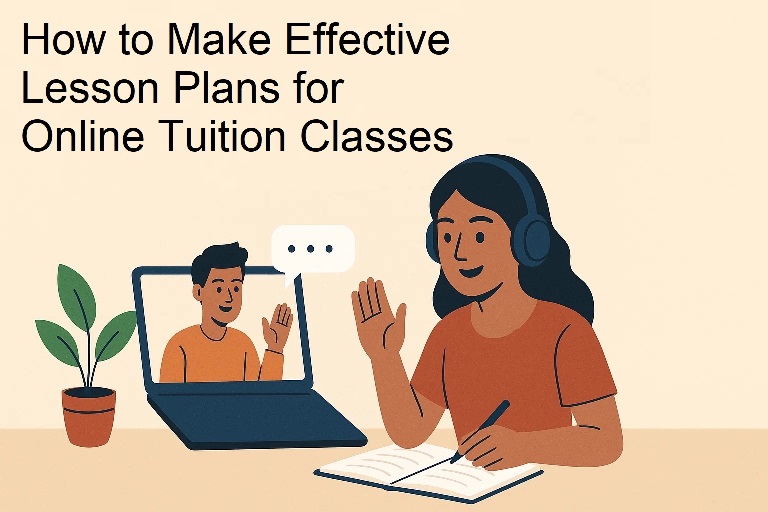Planning is the key to any successful learning session, and this holds especially true for online tuition classes. Whether you’re teaching a 6-year-old math or preparing a high school student for board exams, a well-structured lesson plan can make all the difference. In this article, I’ll walk you through a simple and effective approach to designing lesson plans that actually work in the online teaching environment.
Why Lesson Planning Matters More in Online Tuition
In traditional classrooms, a lot can be managed on the go. But online classes have their own set of challenges — screen fatigue, distractions, and limited face-to-face interaction. Without a plan, it’s easy for sessions to lose focus.
A well-thought-out lesson plan helps:
-
Keep the student engaged and attentive
-
Cover the right content within time
-
Track learning outcomes effectively
-
Build confidence for both student and tutor
According to a 2023 report by Education World, students retain 40% more content in online classes that follow a structured lesson plan compared to unplanned sessions.
Step-by-Step: How to Make an Effective Online Lesson Plan
Let’s break it down into practical steps:
1. Know Your Student
Before planning anything, understand your student’s:
-
Learning level
-
Strengths and weaknesses
-
Goals (e.g., exam preparation, concept clarity)
-
Preferred learning style
For example, if you’re teaching a 9th grade CBSE science student who is weak in Physics, focus more on visuals, real-life examples, and simplified explanations.
2. Set Clear Learning Objectives
Each session should have 1–3 specific learning goals. For example:
-
Understand Newton’s Laws of Motion
-
Solve 5 practice problems related to force and motion
-
Watch a short demo video and explain the experiment
Clear goals give direction to both tutor and student and help measure progress.
3. Structure Your Session Wisely
A typical 60-minute online class can be structured like this:
-
5 mins – Warm-up or recap of previous session
-
10 mins – Introduction to new concept
-
20 mins – Concept explanation using examples, visuals, or screen share
-
15 mins – Practice time (questions, exercises, discussion)
-
5 mins – Summary and student Q&A
-
5 mins – Homework or follow-up task
Adjust the time based on your student’s attention span. For younger kids, sessions might need to be shorter and more interactive.
4. Use the Right Tools
Online teaching gives us access to many resources. Use them well:
-
Google Slides or Canva for visual lessons
-
Whiteboard apps like Jamboard or Ziteboard
-
YouTube videos or animations
-
Quizzes using Kahoot or Quizizz
-
PDFs or worksheets shared through email or WhatsApp
Studies show that visual aids improve online learning retention by over 65%, especially in subjects like science and math.
5. Include Active Learning
Don’t make it one-way. Ask questions, conduct mini-quizzes, or assign short tasks during class. Encourage your student to speak, solve, and explain. This not only keeps them engaged but also builds confidence.
Example: If you’re teaching English grammar, instead of just explaining the rules, ask them to spot errors in sample sentences.
6. Keep Track of Progress
Maintain a simple tracker for each student. Note:
-
What was taught
-
How well the student understood
-
Homework given and completed
-
Topics to revise next time
This helps in preparing the next lesson and also shows parents that learning is happening with clear results.
7. Be Flexible
Online teaching requires flexibility. If a student is not grasping a topic as planned, be ready to slow down, change your examples, or revise before moving forward.
Remember, consistency beats speed when it comes to long-term learning.
Real-World Example
Ritu, a tutor on IndiaTutor.in, teaches Class 7 maths online. She noticed her student struggled with fractions. She planned a week’s lessons just around this topic — using pizza diagrams, online quizzes, and even asked the student to measure ingredients while baking at home. The student not only understood fractions better but started enjoying math again.
My Thoughts
Creating effective lesson plans doesn’t need to be complicated. With a little preparation, you can make every online class productive and enjoyable for your students. Over time, you’ll find a rhythm that works best for you and your learners.
At IndiaTutor.in, we encourage tutors to continuously improve their teaching methods, and lesson planning is at the heart of it. It shows your commitment and builds trust with students and parents alike.
By Nidhi Mehta, Founder – IndiaTutor.in
To share your Feedback or Review – Contact Us
Are you a Tutor? Register your Tutor profile on India Tutor to connect with Students in India and Abroad.
Are you a Parent or Student? – Submit Tutor Wanted Form to reach relevant tutors registered on IndiaTutor.in.
Do you own a Tuition Center? Want to connect with students in your local area? List your center with us.
Free Online Self Evaluation Tests for Tutors and Students
Read our Reviews Have Questions? Read FAQs

